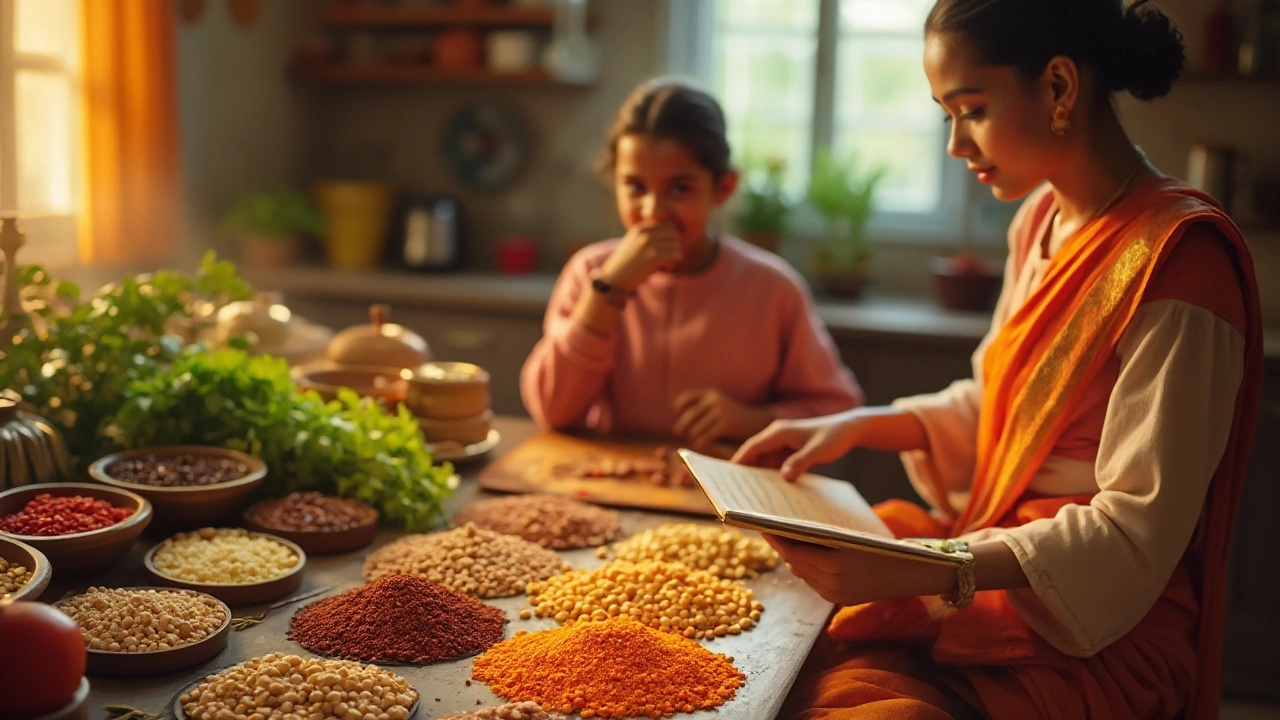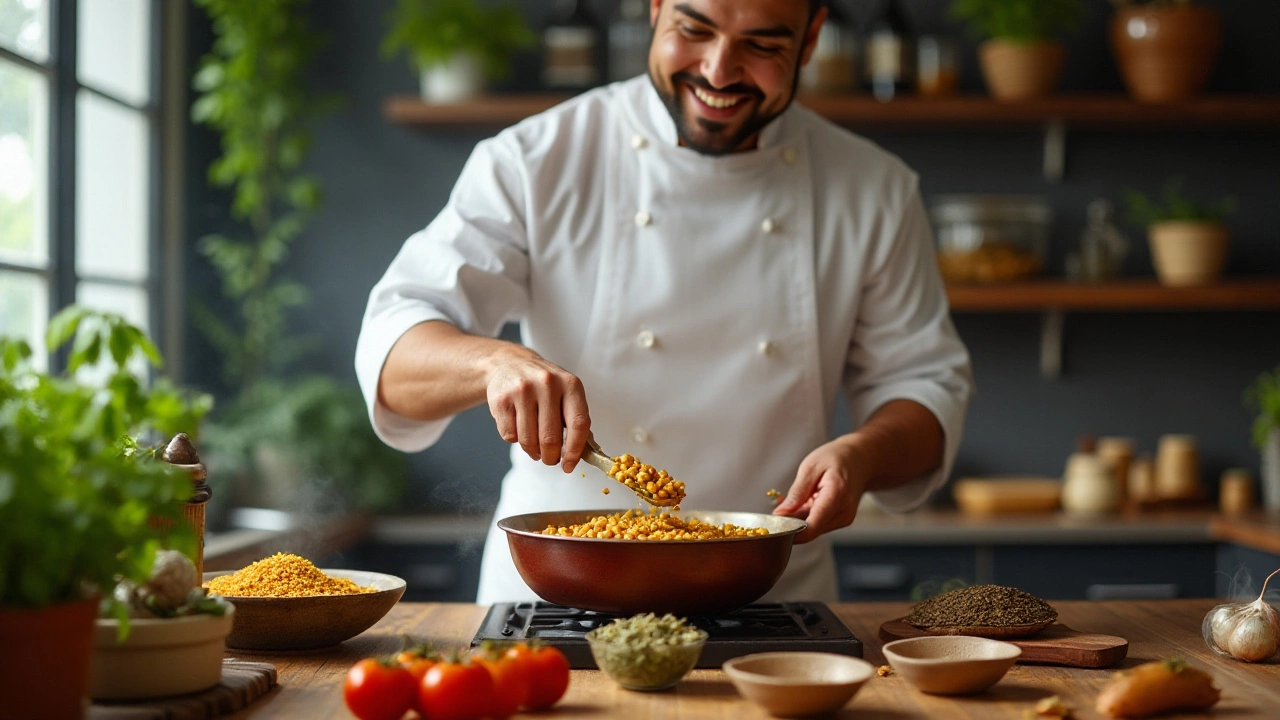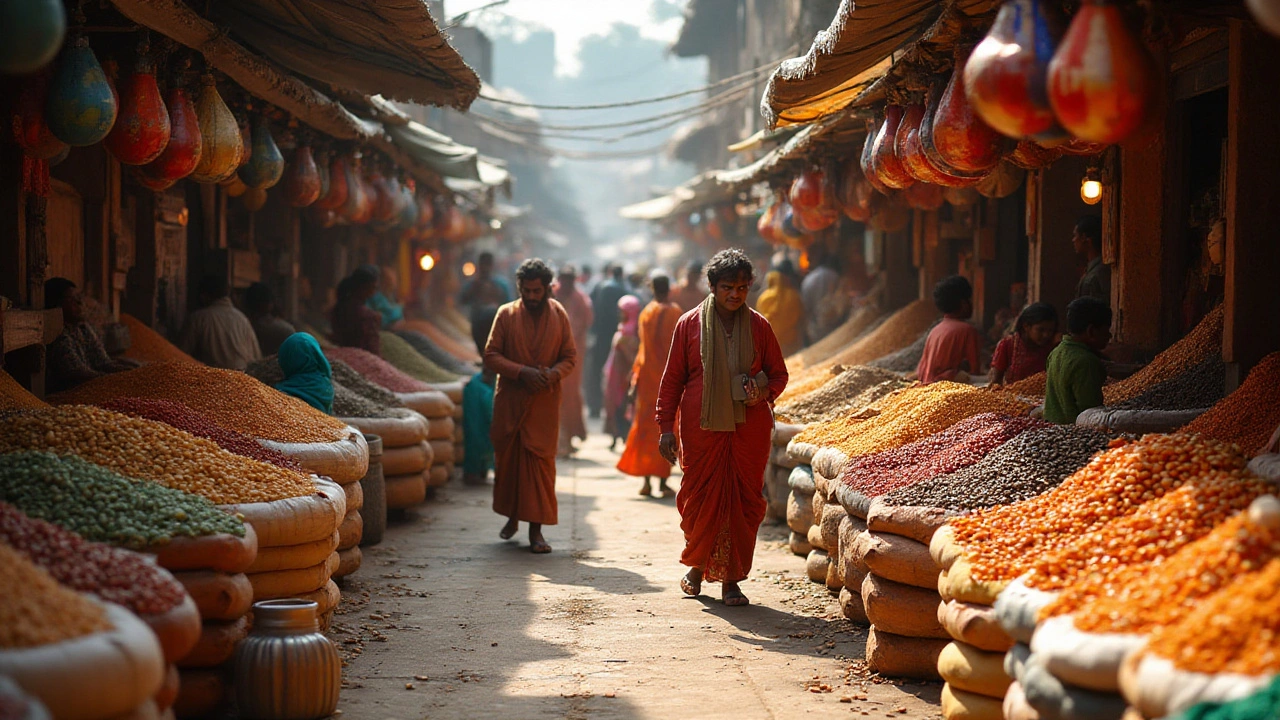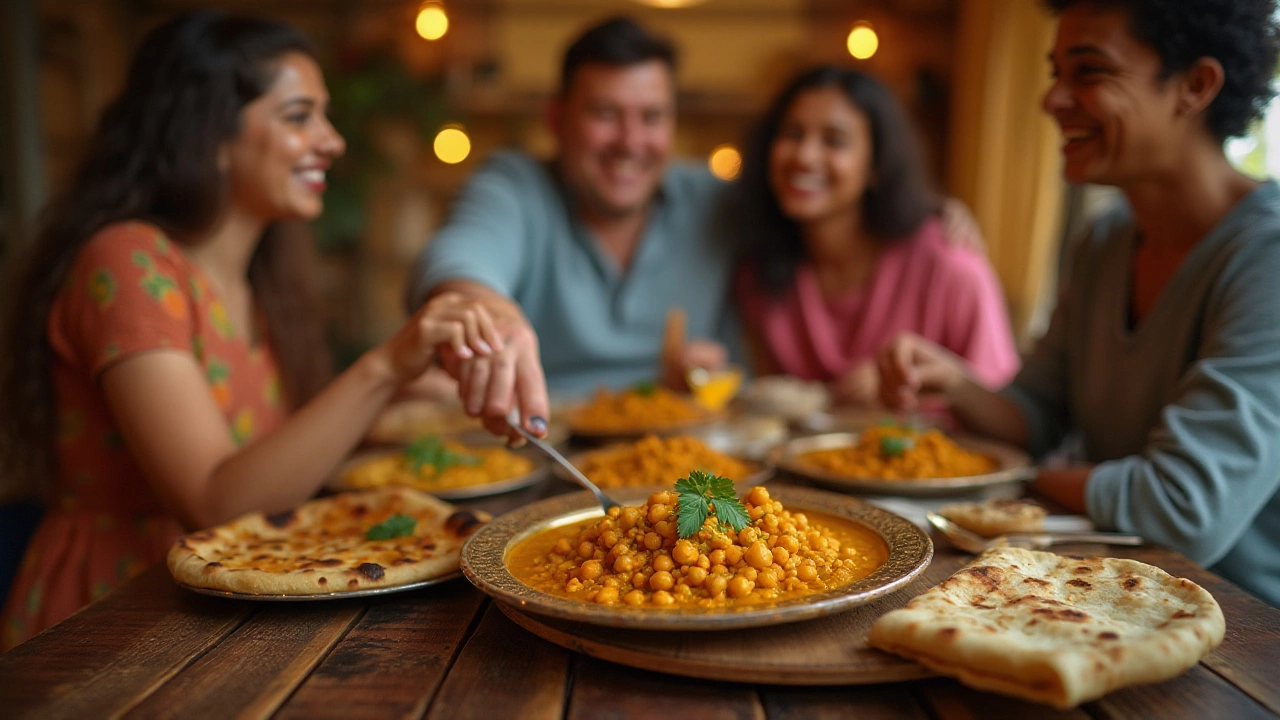Chickpeas vs. Lentils: Nutritional Benefits and Tasty Dal Recipes
 Jan, 26 2025
Jan, 26 2025
In the colorful world of legumes, chickpeas and lentils stand out as nutritional powerhouses that have been delighting taste buds and nourishing bodies for centuries. These versatile ingredients not only enhance the flavors of any meal but also offer a host of health benefits that make them worthy staples in any diet.
As we unravel the individual strengths of chickpeas and lentils, we'll delve into their nutritional profiles, explore their unique offerings, and provide tasty, simple dal recipes that you can easily whip up at home. Join us as we embark on a culinary journey with these beloved legumes, uncovering their secrets and discovering how they can add both taste and health to our lives.
- Nutritional Comparison of Chickpeas and Lentils
- Health Benefits of Chickpeas
- Health Benefits of Lentils
- Simple Dal Recipes Featuring Chickpeas and Lentils
Nutritional Comparison of Chickpeas and Lentils
Diving into the nutritional world of chickpeas and lentils is like opening a door to a treasure trove of health benefits. Both are stalwarts in the realm of legumes, revered for their high protein, fiber, and mineral content. Yet, they each bring unique attributes to the table that can impact your diet and health differently. Chickpeas, also known as garbanzo beans, are particularly high in protein and boasting a remarkable profile of essential amino acids, make them a valuable addition to vegetarian and vegan diets. Meanwhile, lentils, those tiny lens-shaped pulses, pack a serious punch of folate and iron, essentials for maintaining healthy blood and supporting cognitive functions.
When we talk numbers, a cup of cooked chickpeas contains approximately 15 grams of protein and a whopping 12 grams of fiber. This contrast with lentils, which tend to be ever so slightly higher in protein content, edging up to around 18 grams per cup, while their fiber levels rest comfortably in a similar neighborhood around 16 grams per cup. This fibrous bounty plays a crucial role in digestive health, making both of these legumes champions of the gut. Notably, chickpeas shine in their calcium content, offering a boost for bone health while lentils take the lead in iron, addressing a key nutritional requirement for many individuals, especially women.
It's not just about what's inside these humble legumes, it's about how these nutrients interplay within the body's intricate systems. The presence of antioxidants in chickpeas, like selenium and vitamin C, creates natural defenses against cellular damage, making them an ally in long-term wellness while enhancing skin health. Lentils, on the other hand, are fortified with B-vitamins, particularly folate, which is vital for DNA synthesis and repair. They also contain zinc, an unsung hero in supporting the immune system. Such nutrient profiles not only shape dinner choices but contribute to lasting health benefits.
Choosing between chickpeas and lentils often comes down to macronutrient needs and personal health focus. Aiming for more dietary fiber? Lentils might just edge out chickpeas in helping you hit those daily targets. Looking to up your protein intake with lower calories? Chickpeas offer a mild flavor and nutty texture that seamlessly fit into numerous dishes while being less calorically dense than their lentil counterparts. These profiles highlight the versatility of these legumes in enriching your meals, whether you're crafting a hearty dal, a Mediterranean salad, or adding texture to a stew.
"Including legumes such as chickpeas and lentils in your diet can significantly influence overall health and prevention of chronic diseases." - Journal of NutritionAfter tumbling through grams and nutrients, it's essential not to forget the broader picture. Regardless of the choice between chickpeas or lentils, the overarching benefit remains clear: both are extraordinary options in the quest for healthy eating. In tandem, they offer flexibility in flavor profiles and cooking styles, accommodating diverse culinary traditions around the world, making them not only a nutritious choice but a deliciously simple one for many gastronomic adventures.

Health Benefits of Chickpeas
Chickpeas, also known as garbanzo beans, are a remarkable source of nutrition and have been an essential part of diets across various cultures for thousands of years. Their popularity isn't just due to their versatility in recipes but largely comes from the impressive array of health benefits they offer. One of the most notable advantages of incorporating chickpeas into your meals is their high fiber content, which can play a crucial role in promoting digestive health. The fiber found in chickpeas not only aids in maintaining regular bowel movements but also feeds the healthy bacteria in your gut, contributing to a more balanced gut microbiome. Many nutritionists agree that a well-functioning gut is fundamental to overall health, influencing everything from immune function to mental well-being.
Additionally, chickpeas are rich in protein, making them an excellent dietary choice for vegetarians and vegans looking to meet their daily protein requirements. This plant-based protein is essential for maintaining muscle strength and promoting cellular repair. Interestingly, chickpeas also contain a range of essential vitamins and minerals, such as B vitamins, iron, magnesium, and zinc, each of which plays a critical role in supporting various bodily functions. For instance, iron is vital for the production of red blood cells and the transportation of oxygen throughout the body, helping to prevent anemia and boost energy levels.
A lesser-known benefit of chickpeas is their potential role in weight management. The high fiber and protein content can induce a feeling of fullness, which may help reduce overall calorie intake. Several studies have shown that people who regularly consume chickpeas and other legumes tend to have a lower body weight and waist circumference compared to those who don't. Moreover, chickpeas have a low glycemic index, meaning they release sugar slowly into the bloodstream, making them a great option for managing blood sugar levels and reducing the risk of type 2 diabetes.
Beyond individual health, chickpeas can also have a positive impact on heart health. They contain a variety of nutrients that help improve cholesterol levels, particularly by reducing LDL (bad) cholesterol. This effect has been observed in studies where participants who incorporated chickpeas into their diet had improved cholesterol profiles, which is linked to a lower risk of heart disease. These findings reinforce the importance of chickpeas as part of a heart-healthy diet.
"The benefits of incorporating chickpeas into your diet are manifold, from boosting heart health to aiding digestion," explained Dr. Marian Tapping, a leading nutritionist. "Their nutrient profile is a testament to the advantages of plant-based foods."
As dietary habits shift towards more sustainable and plant-based options, chickpeas stand out not only for their health benefits but also for their environmental friendliness. Requiring relatively low water input and enriching the soil in which they're grown, chickpeas support sustainable agricultural practices, aligning with efforts to reduce ecological footprints. This dual impact—nourishing both the body and the planet—adds another dimension to the allure of chickpeas.

Health Benefits of Lentils
Lentils, small though they may be, pack a significant punch in the realm of nutrition. Known for their high protein content, they have been a crucial part of vegetarian and vegan diets around the world. One of the standout features of lentils is their impressive fiber content, which plays a vital role in maintaining digestive health. Fiber aids in keeping cholesterol levels in check while helping regulate blood sugar, making lentils a great choice for individuals managing diabetes. Additionally, they are rich in complex carbohydrates, which provide a steady source of energy without the sudden spikes associated with simpler carbs.
Lentils come in various types, including red, green, brown, and black, each with its distinctive flavor and texture. A fantastic source of folate, iron, potassium, and manganese, incorporating lentils into your meals can substantially boost your intake of essential vitamins and minerals. Folate, in particular, is crucial for pregnant women as it supports fetal development and aids in the prevention of neural tube defects. Potassium serves as an electrolyte that helps manage blood pressure by negating the effects of excess sodium intake.
Lentils are a versatile ingredient, easily adapting to various dishes, from hearty stews to light salads. It's worth noting that lentils are also low in fat, which makes them an ideal food choice for those looking to manage or lose weight. They satiate hunger without adding unnecessary calories, helping people not overeat and allowing them to stay fuller for longer.
Lentils are a true superfood. They offer an affordable and sustainable protein source that’s hard to surpass in nutritional density." - Nutrition Today
For those focused on environmental impact, lentils are an excellent choice due to their relatively low carbon footprint compared to animal-based proteins. Growing lentils requires less water and energy, making them a sustainable food source for the future. This aspect of chickpeas and lentils highlights the broader context of selecting foods that are kind to both our bodies and the planet.
With lentils, you're not just eating a meal – you're investing in your long-term health, supporting your body with essential nutrients while also opting for a sustainable source of nourishment. So the next time you're planning your menu, consider adding a hearty lentil dal to the mix, reaping the myriad health benefits they so graciously offer.

Simple Dal Recipes Featuring Chickpeas and Lentils
Creating a simple yet delicious dal using chickpeas and lentils is as rewarding as it is nutritious. These staples not only form the perfect base for a satisfying dish but also bring out the authentic flavors of traditional cuisine. To kick off this culinary adventure, imagine combining the creamy, nutty essence of chickpeas with the earthy, tender nature of lentils, crafting a symphony of taste and texture that speaks to the heart.
Let's start with a simple recipe for Chickpea and Lentil Dal. Begin by soaking a cup of chickpeas overnight; this not only enhances their texture but also aids digestion, releasing valuable nutrients. The next morning, drain and rinse them, and cook them in generous water until they achieve a tender personality. Meanwhile, gather your ingredients for this warming dish: a cup of red lentils that cook quicker, a finely chopped onion, crushed garlic cloves, and a piece of ginger root grated for that kick of spice.
In your favorite heavy-bottomed pot, warm some oil and toss in the onions, letting them dance until they turn a perfect golden brown. Add the garlic and ginger, allowing their aromas to fill the air, drawing everyone into the kitchen. As they sizzle together, sprinkle in a teaspoon of cumin seeds followed by a couple of bay leaves, forming a base for the layering of complex flavors. Chickpeas and lentils become the stars of this dish, as you add them into the mix along with a generous teaspoon of turmeric and a criminally important pinch of salt.
Let the dal simmer, with just enough water to cover, as the fibers of the lentils break down and embrace the water into a silky consistency. Stir occasionally, ensuring nothing sticks to the bottom and all ingredients merge seamlessly into a cohesive blend of flavors. It's here that you can make the recipe your own, adding a dash of chili powder for heat, or a touch of garam masala for depth, personalizing it according to your palate.
After around thirty minutes of simmering, the dal reaches its perfect form, with a thick, hearty consistency ready to embrace warm naan or a bowl of fluffy, steaming rice. Top it off with a squeeze of lemon juice and a sprinkle of freshly chopped cilantro, and your meal is ready to ignite your senses. There's a certain beauty in crafting such meals – a shared experience that connects cultures and adds warmth to household gatherings.
"Cooking is like love. It should be entered into with abandon or not at all," as Harriet Van Horne famously said, captures the essence of preparing dal, a dish made with care and passion.
This recipe is not just about fulfilling hunger but about celebrating ingredients that have traveled across continents to become staples in kitchens worldwide. Whether you choose chickpeas or lentils, embracing these ingredients in your dal recipes is about more than taste; it's a nod to history, culture, and nourishment that binds us.
